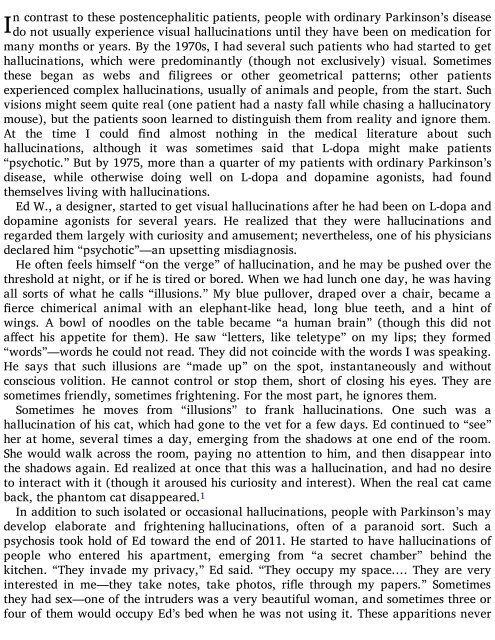32896589326509350
You also want an ePaper? Increase the reach of your titles
YUMPU automatically turns print PDFs into web optimized ePapers that Google loves.
I<br />
n contrast to these postencephalitic patients, people with ordinary Parkinson’s disease<br />
do not usually experience visual hallucinations until they have been on medication for<br />
many months or years. By the 1970s, I had several such patients who had started to get<br />
hallucinations, which were predominantly (though not exclusively) visual. Sometimes<br />
these began as webs and ligrees or other geometrical patterns; other patients<br />
experienced complex hallucinations, usually of animals and people, from the start. Such<br />
visions might seem quite real (one patient had a nasty fall while chasing a hallucinatory<br />
mouse), but the patients soon learned to distinguish them from reality and ignore them.<br />
At the time I could nd almost nothing in the medical literature about such<br />
hallucinations, although it was sometimes said that L-dopa might make patients<br />
“psychotic.” But by 1975, more than a quarter of my patients with ordinary Parkinson’s<br />
disease, while otherwise doing well on L-dopa and dopamine agonists, had found<br />
themselves living with hallucinations.<br />
Ed W., a designer, started to get visual hallucinations after he had been on L-dopa and<br />
dopamine agonists for several years. He realized that they were hallucinations and<br />
regarded them largely with curiosity and amusement; nevertheless, one of his physicians<br />
declared him “psychotic”—an upsetting misdiagnosis.<br />
He often feels himself “on the verge” of hallucination, and he may be pushed over the<br />
threshold at night, or if he is tired or bored. When we had lunch one day, he was having<br />
all sorts of what he calls “illusions.” My blue pullover, draped over a chair, became a<br />
erce chimerical animal with an elephant-like head, long blue teeth, and a hint of<br />
wings. A bowl of noodles on the table became “a human brain” (though this did not<br />
aect his appetite for them). He saw “letters, like teletype” on my lips; they formed<br />
“words”—words he could not read. They did not coincide with the words I was speaking.<br />
He says that such illusions are “made up” on the spot, instantaneously and without<br />
conscious volition. He cannot control or stop them, short of closing his eyes. They are<br />
sometimes friendly, sometimes frightening. For the most part, he ignores them.<br />
Sometimes he moves from “illusions” to frank hallucinations. One such was a<br />
hallucination of his cat, which had gone to the vet for a few days. Ed continued to “see”<br />
her at home, several times a day, emerging from the shadows at one end of the room.<br />
She would walk across the room, paying no attention to him, and then disappear into<br />
the shadows again. Ed realized at once that this was a hallucination, and had no desire<br />
to interact with it (though it aroused his curiosity and interest). When the real cat came<br />
back, the phantom cat disappeared. 1<br />
In addition to such isolated or occasional hallucinations, people with Parkinson’s may<br />
develop elaborate and frightening hallucinations, often of a paranoid sort. Such a<br />
psychosis took hold of Ed toward the end of 2011. He started to have hallucinations of<br />
people who entered his apartment, emerging from “a secret chamber” behind the<br />
kitchen. “They invade my privacy,” Ed said. “They occupy my space.… They are very<br />
interested in me—they take notes, take photos, rie through my papers.” Sometimes<br />
they had sex—one of the intruders was a very beautiful woman, and sometimes three or<br />
four of them would occupy Ed’s bed when he was not using it. These apparitions never

















